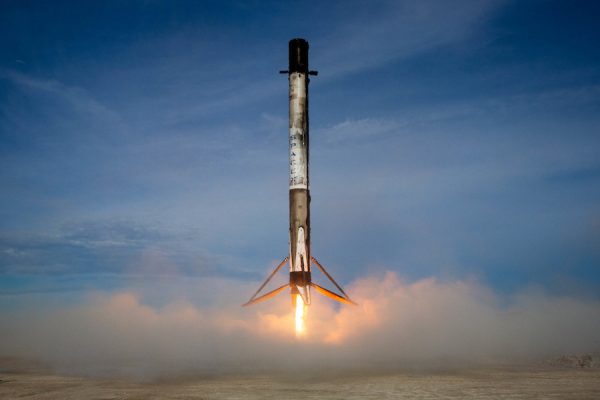SpaceX’s next launch to mark another incremental step in rocket reusability – Spaceflight Now

SpaceX next mission, slated to carry the company’s second set of Starlink broadband satellites into orbit, will be the first to fly with a reused Falcon 9 booster making its fourth launch when it takes off in the coming weeks.
Hans Koenigsmann, SpaceX’s vice president of build and flight reliability, confirmed earlier this week the plan to use a thrice-flown booster on the next Falcon 9 launch.
The next SpaceX launch is expected in the next few weeks — either in late October or November — from pad 40 at Cape Canaveral.
The Falcon 9 will deploy the Starlink satellites into orbit a few hundred miles above Earth. The flight profile is expected to be similar to the first Starlink launch in May, when a Falcon 9 delivered 60 microsatellites to space. The satellites used on-board electric thrusters to maneuver into orbits roughly 341 miles (550 kilometers) above Earth, inclined 53 degrees to the equator.
The exact number of Starlink satellites set to launch on the next mission has not been confirmed by SpaceX.
The upcoming Starlink flight will be the 27th time SpaceX has launched a previously-flown booster since 2017. Seven of SpaceX’s 10 launches this year have flown with recycled first stage boosters, which either returned to propulsive touchdowns on land or on SpaceX’s offshore drone ships.
SpaceX also reuses Dragon cargo capsules flying on resupply missions to the space station. The company’s new second-generation Dragon design, designed for astronauts, can fly in space up to five times, but will initially only be reused for unpiloted cargo missions.
“Currently we use our boosters 10 times, they’re designed for 10 times,” Koenigsmann said Monday during a panel discussion at the annual meeting of the National Academy of Engineering. “We’re going to start with a fourth time with the next launch, actually. Dragon has been used three times, Crew Dragon will be used up to five times (initially only for cargo missions). So all these things help because you don’t have to build something again. You have to inspect it, refurbish it where you need to refurbish it, but ideally you need to keep that really, really low.”
SpaceX’s ability to reuse rocket hardware has allowed the company to reduce prices. The next component SpaceX wants to reuse is the fairing, the structure that protects satellites during the first few minutes of each launch.
The fairing jettisons in two pieces in a clamshell-like fashion. SpaceX has added cold gas thrusters and parachutes to the fairing halves ,and the company’s recovery vessel — fitted with a giant net — successfully caught a fairing for the first time after a launch in June.
“We just recently recovered a fairing coming from the second stage, basically, in a big net and saved it from … falling into the water, which is super useful, and then we’re going to refurbish that,” Koenigsmann said.
Repeating a familiar message from SpaceX executives, Koenigsmann said cutting the time needed to inspect and refurbish rockets between flights is critical to sustaining a human presence on Mars, a core part of the company’s founding mission.
“Obviously, the big technical problem going to Mars is money,” he joked. “There are some technical problems, too. Money plays into that. Spaceflight is super expensive, so one obvious knob to turn is reusability, and it’s not just reusability, it’s rapid reusability.
SpaceX is developing the next-generation Starship vehicle and Super Heavy booster to enable a range of missions, including human expeditions to the moon and Mars, and a high volume of satellite launches. The Starship, which acts as the upper stage for the combined vehicle, and its Super Heavy booster will be entirely reusable.
“Then it really becomes the cost of the fuel and the cost of some maintenance and operations, basically,” Koenigsmann said. “That’s where we need to go. That’s the technical side.”
SpaceX still needs customers and users for the Starship, Koenigsmann said.
“We need payloads. We need users. We need people that actually use that service,” he said. “That’s basically where everybody can kind of pitch in here and help us. Obviously, if you have this capability, somebody needs to use it, and that’s super important, too.”
The Super Heavy/Starship vehicle will stand nearly 400 feet tall and will be able to loft up to 150 tons of payload to low Earth orbit, according to SpaceX, while keeping a fuel reserve for landing. That’s more than twice the lift capability of SpaceX’s Falcon Heavy rocket.
Email the author.
Follow Stephen Clark on Twitter: @StephenClark1.






